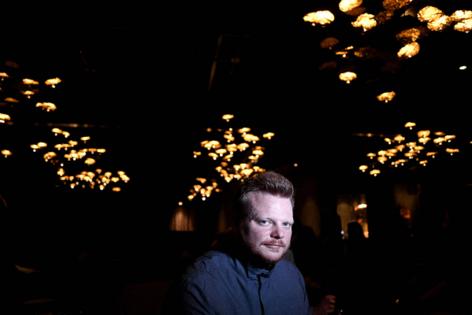$500,000 space dining isn't all that out there
Published in Variety Menu
I received lots of email from non-foodie friends when the announcement came that Rasmus Munk, the chef of two-starred Michelin restaurant Alchemist, was going to prepare a meal on the edge of space for people willing to fork over $500,000 each for the privilege of what is literally haute cuisine. My friends were very excited about this most lofty of destination restaurants. They weren’t really gourmets (or gourmands like myself), but imagining the rarity of the experience enraptured them.
I’m all for adventurous eating — I am an aficionado of offal and other things that many folks in the West still recoil from. But, if someone offered me a chance to be launched, as Buzz Lightyear would say, toward “infinity and beyond” for a meal, I’d say, “After you.”
That’s just me. Others may savor the sense of daring and the possibility of seeing the glorious vista of the curve of the earth from 30 kilometers (18.6 miles or more than 98,400 feet) above the planet’s surface. As distances go, that’s not quite as high up as the International Space Station’s 408 km. It is, however, considerably higher than the heights flown by commercial passenger planes, which are capped at around 40,000 feet.
I’m sure lawyers are drawing up liability waivers just as similar documents were issued for passengers on the ill-fated Titanic submersible that was launched and lost in June 2023 as it headed toward the wreckage of the 20th century luxury liner. But the science behind Spaceship Neptune — on which Munk will serve his cuisine — isn’t off-the-shelf technology like the unfortunate Titan’s. The engineering principles behind it were pioneered by NASA years ago and are now being implemented for commercial use. For those hoping for a fiery liftoff a la the Apollo space launches, well, you won’t get that. Neptune’s gondola will be lofted skyward by an enormous space balloon, rising to its 30 kilometer height at a gentle 12 mph (less than 20 kph). Apollo 11, the historic mission to the moon, lifted off at 25,500 mph.
Neptune’s not going that far. At its rate, the spaceship will take more than an hour to get to its peak. That will leave passengers with five more hours to enjoy their meal and return to earth. But that’s what I’m interested in: the food. Munk’s mission isn’t the first commercial dine-in-space venture — a French company called Zephalto announced a similar project (at a bargain $132,000 per diner) in March 2023, as my Bloomberg colleague Sarah Rappaport wrote. Both Neptune and Zephalto plan their first voyages in 2025.
What Neptune has is the Danish chef, who is now the most prominent purveyor of what’s called Modernist food, a style of cuisine that encompasses the so-called molecular gastronomy made famous by Ferran Adria at El Bulli as well as the many innovations seen since that pioneering restaurant on the Catalan coast closed its reservation books in 2011. Munk calls his version of the movement “holistic cuisine” — bringing to it the various strands of ecology, equality and climate consciousness prevalent in the world today. If anyone is destined to bring haute cuisine to the atmospheric heights in a spaceship, it’s Munk.
So, I’d be most curious to see how he will bring the science-lab atmosphere of his food development (the kitchen at Alchemist is a wonder) to the physical challenges of lowered gravity (technically, space begins 100 km above sea level; and zero gravity — that is, being completely free of the earth’s pull — requires a distance of 13 million miles).
As many non-scientists already know, food in airplanes can taste different from terrestrial dining. And the food at the various space stations has been far from gourmet. China’s space station has brought the strong regional flavors of Sichuan to the highest reaches — with microwaves to heat up the food too. Munk’s cuisine is gorgeous to behold and delicate to the touch and palate — but can those hold up, even at a gentle 12 mph wafting into the edge of space? Will he serve his edible butterflies on the Neptune?
I believe he is up to the challenge, as difficult as it may be. In February, I was part of a group of journalists who visited Spora, his food-development lab a couple minutes’ walk from Alchemist on Refshalevej in a revived former industrial section of Copenhagen. I’d written about it before but now I got to see what he was doing, which included an astonishing skewer made of “upcycled” vegetable discards that tasted astonishingly close to a sausage. It’s a work in progress. But Spora has already come up with a fantastic chocolate made without cacao (an ingredient that is placing huge stresses on growers because of climate change).
That’s the kind of novelty that would tempt me to go into space. Of course, there’s that price tag (which will narrow the customer base to the six people who can get into the Neptune capsule).“We’re aware that it’s an expensive first journey. But this is after all the first launch with these food experiences on board,” Munk told my Copenhagen colleague Sanne Wass. The chef will be on board the Neptune to serve the food himself. Unless I can come up with the amount, I’ll wait for him to return to earth with leftovers.
____
This column does not necessarily reflect the opinion of the editorial board or Bloomberg LP and its owners.
Howard Chua-Eoan is a columnist for Bloomberg Opinion covering culture and business. He previously served as Bloomberg Opinion's international editor and is a former news director at Time magazine.
©2024 Bloomberg L.P. Visit bloomberg.com/opinion. Distributed by Tribune Content Agency, LLC.







Comments